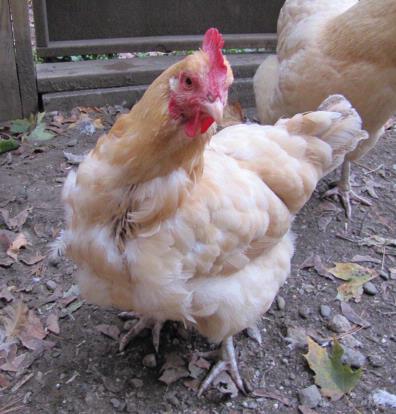I have seven Buff Orpington chickens that look essentially identical. Tiny, who has always been a character, sticks out because she’s small and has a few black tail feathers. Despite her size, Tiny has what passes for charisma in a chicken.
Until I reinforced and raised the fence around the freedom-through-laying detention center, Tiny flew the coop on a regular basis. At one point she escaped every day to lay eggs in the neighbor’s brush pile. One of our neighbor’s boarders found the missing eggs after a few weeks. I decided to eat all fourteen of them anyway, though not in one sitting. I did not die.
Tiny is in the middle of her fall molt. She looks laughable with brand new feathers poking out from amongst all of her old feathers. She needs a bit of extra protein during the molt, so I get the feeling she’s eying me for weaknesses every time I walk past the coop. She’s also stopped laying, but when she’s done she’ll hopefully have a renewed productivity.

In the commercial poultry industry growers sometimes force molts to reinvigorate egg laying. They do this by cutting off food for a week or so. It’s kind of a fasting-purge type thing, only the chickens don’t get to choose and they don’t like it.
As I was looking at Tiny and imagining getting her a little sweater to help her stay warm, I thought how ridiculous a theropod dinosaur might have looked in mid-molt (I suppose I’d giggle as I was running away). It’s not as preposterous as it seems; birds are direct decedents of dinosaurs. They are dinosaurs as we are apes (actually we’re a lot closer to apes). Birds evolved from the dinosaur lineage – crocodiles and alligators split off earlier, so are less like dinosaurs. Not all dinosaurs had feathers, but there were many that had feathers or hollow proto-feather filaments.
Some dinosaurs molted, because their feathers, or proto-feathers, would wear out and need to get replaced. This suggests another question that I have not really been able to resolve. Feathers are structures made of the same proteins that make scales in crocodiles and on bird legs. Crocodiles even have the follicle-like structures and genes expressed to make feathers as embryos. So is bird molting regulated by the same hormonal processes that regulate skin molting in lizards? What about in snakes? Molting is still not fully understood even by the pointy-heads who study this sort of thing.
I’m quite glad I don’t have to go through a molt. I suppose the gawky teenage stage I went through from about 13 to my mid-thirties felt the way that Tiny looks, but I’m glad that once a year I don’t look as if my skin is falling off in clumps. It would be very embarrassing. I can just imagine passers-by snickering “look at him he’s molting ewww.”


